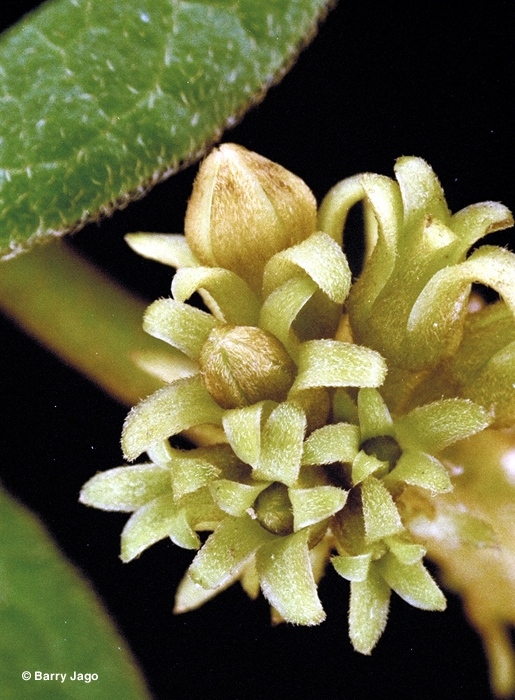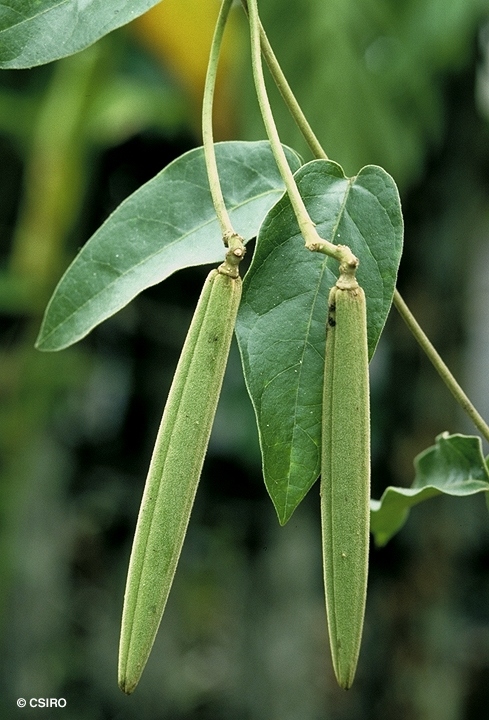Australian Tropical Rainforest Plants - Online edition
Parsonsia velutina R.Br.






Brown, R. (1810) Prodromus Florae Novae Hollandiae : 466. Type: Queensland, probably Keppel Bay, 1802, R. Brown; holo: ?BM. Fide J. B. Williams, Fl. Austral. 28: 181 (1996).
Silkpod, Hairy; Hairy Silkpod
A slender vine not exceeding a stem diameter of 2 cm.
Petioles and twigs clothed in brown hairs. Twigs and petioles produce a clear exudate when cut or broken or do not produce any exudate. Leaf blades about 6.5-13 x 3-7 cm, petioles about 1-3 cm long. Lateral veins about 6-8 on each side of the midrib. Peg-like glands about 1 mm long present at the base of the petioles. Upper and lower leaf blade surfaces clothed in erect brown hairs. Markings resembling stipular scars often visible on the twigs between the points of attachment of the petioles.
Primary peduncle about 7-8 cm long. Flowers about 5-6 mm diam. Pedicels about 2 mm long. Sepals hairy, reflexed, about 2.5 mm long. A small finger-shaped gland about 0.5 mm long usually present on the inside near the base opposite each sepal. Corolla tube about 1.7 mm long, lobes about 2 mm long. Hairs present on the inner surface near the base of the corolla lobes. Staminal filaments about 1 mm long, upper section clothed in hairs. Anthers cohering in a cone around the style. Anther bases sagittate. Disk glands 5, bilobed, opposite the sepals. Style about 1.5-2 mm long. Ovules numerous.
Fruits about 7.5-10 x 0.7-1 cm, outer surface clothed in brown +/- erect hairs, calyx lobes persistent at the base. Seeds about 6-8 mm long. Plumes brown, about 10-25 mm long. Testa longitudinally grooved. Embryo about 4-6 mm long. Cotyledons may be folded lengthways. Cotyledons lanceolate, about 3.5-4 x 1 mm, much wider than the radicle. Radicle about 1.5 mm long.
Cotyledons about 14-17 x 7-10 mm. First leaf ovate, second leaf elliptic, both the upper and lower surfaces clothed in hairs. usually about 7 hairy stipule-like glands (each about 1 mm long) present at each node. Hypocotyl hairy. At the tenth leaf stage: leaf blade elliptic to lanceolate, about 8-9 x 3-4 cm, apex acute to acuminate, base auriculate, upper surface mainly glabrous, lower surface clothed in short brown hairs. Stipules or glands about 1.5-2 mm long. Stems scabrid. Vein angle of the basal pair of veins lower than subsequent lateral veins. Seed germination time 20 to 27 days.
Food plant for the larval stages of the Cairns Hamadryad and Common Crow Butterflies. Common & Waterhouse (1981); Sankowsky & Neilsen (2000).





